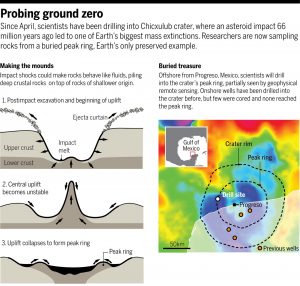Recently there have been a few stories about a scientific project to learn more about the asteroid that led to the extinction of the dinosaurs. Researchers Joanna V. Morgan of the Imperial College of London and Sean P. S. Gulick of the University of Texas at Austin have been drilling thirty kilometers off the Yucatán peninsula in the Gulf of Mexico looking for the inner “peak” ring inside the larger crater rim caused by the asteroid that struck Earth 66 million years ago. To see the original article in Science click the link below.
These inner rings of craters have been often seen on our Moon and other Planets and moons in the solar system but where unknown here on Earth before now. With the samples of granite and other materials retrieved by the scientists we are now able to study this type of crater formation up close.
The present model for the formation of these double ringed craters is shown in the figure below.

Data and samples gained from the present drilling project will help to either confirm or reject the current model.
Like the dinosaurs, we are still threatened by another such disastrous collision from outer space. Unlike them however we are beginning to develop the necessary technology to recognize the threat before it strikes and someday soon to prevent the disaster from occurring.
Quick update: Just this morning a new article in Live Science has reported that the scientists drilling into the Yucatan crater believe that the asteroid may have actually punctured the Earth’s crust. If that is true some of the samples the team are finding may be material from the Earth’s mantel, a region of our planet less well explored than our Moon. Use the link below to read the article.
http://www.livescience.com/56914-dino-killing-asteroid-punched-through-earths-crust.html
